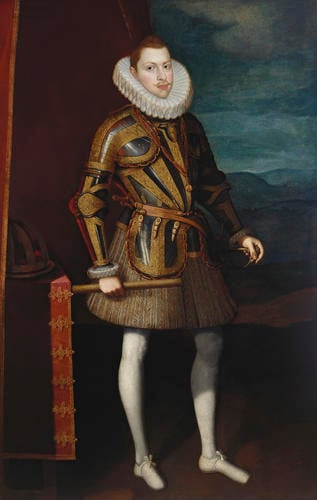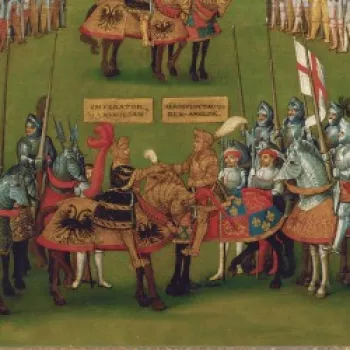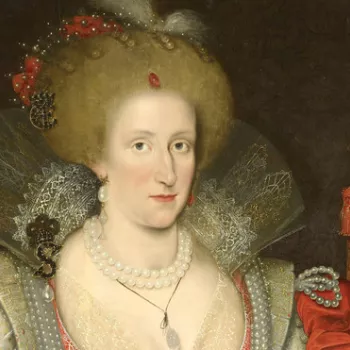Philip III, King of Spain (1578-1621) Signed and dated 1605
Oil on canvas | 184.4 x 118.5 cm (support, canvas/panel/stretcher external) | RCIN 404969
-
Juan Pantoja de La Cruz was the foremost Spanish portrait painter of the late sixteenth and early seventeenth century and served as court painter to both Phillip II and Phillip III of Spain. This bold painting follows in the tradition of Spanish royal portraits established in by earlier generations and was designed to convey an image of courtly majesty. Juan Pantoja de La Cruz received his training in the Madrid workshop of court painter Alonso Sánchez Coello (1532-1588), whose work is also represented in the Royal Collection (see RCINs 405798, 404331). Here Pantoja learned the traditions of Spanish royal portraiture. The sixteenth century Spanish School had been stimulated by Italian influences, in particular by Titian and his work for the Spanish court (c. 1548 - 1570). A follower of Titian, Sánchez Coello had pioneered the Spanish manner of portraiture with the additional influence of his Netherlandish master Anthonis Mor van Dashorst (see RCINs 405799). Pantoja is known to have collaborated to a significant extent on many of his master's mature works and there are a number of anonymous paintings from the workshop which are likely by him. There are relatively few signed works by Pantoja prior to the death of Sánchez Coello in 1588, though he was by then an independent artist. Pantoja did not take his master's place as an official court painter until the accession of Philip III in 1598; however, a number of royal portraits including one of Don Philip, the future Philip III (Kunsthistorisches, Vienna) survive from as early as 1590.
Concerned more with the portrayal of solemn and imposing majesty than with reproducing an individual likeness, Pantoja's style of portraiture perpetuated that of Sánchez Coello, reflecting the influences of both the Venetian and Flemish traditions. His portraits are characterized by a precise handling of elaborate textures and a Netherlandish precision in the rendering of detail, particularly as regards the ornate attire and jewels worn by the court. However, in his treatment of faces he clearly references the Venetian school, in particular Titian, whose famous portrait of Charles V (Alte Pinakothek, Munich) he is known to have copied.
This portrait of Phillip III is one of several important works dating from the years 1605 and 1606 and was given as a gift to James I in 1605 following the signing of a peace treaty between England and Spain. It is typical of Pantoja's royal portraits. The King is shown standing in majestic isolation wearing an engraved breast plate over doublet and hose. In his right hand he holds a baton while his left hand rests on the hilt of his sword, as if ready to draw it at any moment, on the table beside him his crown lies partially obscured by red drapery. During the period in which this portrait was painted, Spain was at war with the rebellious Dutch in the Spanish Netherlands. Pantoja's image portrays Phillip III not only as a warrior king, but in keeping with the ideology of Spanish Habsburg rule, which promoted the belief that as the monarch was ordained by God, he should exemplify the Christian virtues; Phillip in his armour embodies fortitude.Philip III has been posthumously described as an 'undistinguished and insignificant man' and during his own lifetime he was criticized for over-reliance on his corrupt chief minister, the Duke of Lerma. For many historians, the decline of Spain can be dated to the economic difficulties that began during the early years of Philip III's reign. However, as the ruler of the Spanish Empire at its height and as the king who achieved a temporary peace with the Dutch (1609–1621), Philip III's reign remains a critical period in Spanish history.
Provenance
Given to James I by Phillip III of Spain; sold as a pair for £15 to Robert Houghton and others on 23 October 1651 (no 331); recovered at the Restoration and listed in the 2nd Privy Lodging Room at Whitehall in 1666 (no 215)
-
Medium and techniques
Oil on canvas
Measurements
184.4 x 118.5 cm (support, canvas/panel/stretcher external)
205.0 x 140.3 x 7.2 cm (frame, external, + buildup)
Category
Object type(s)










